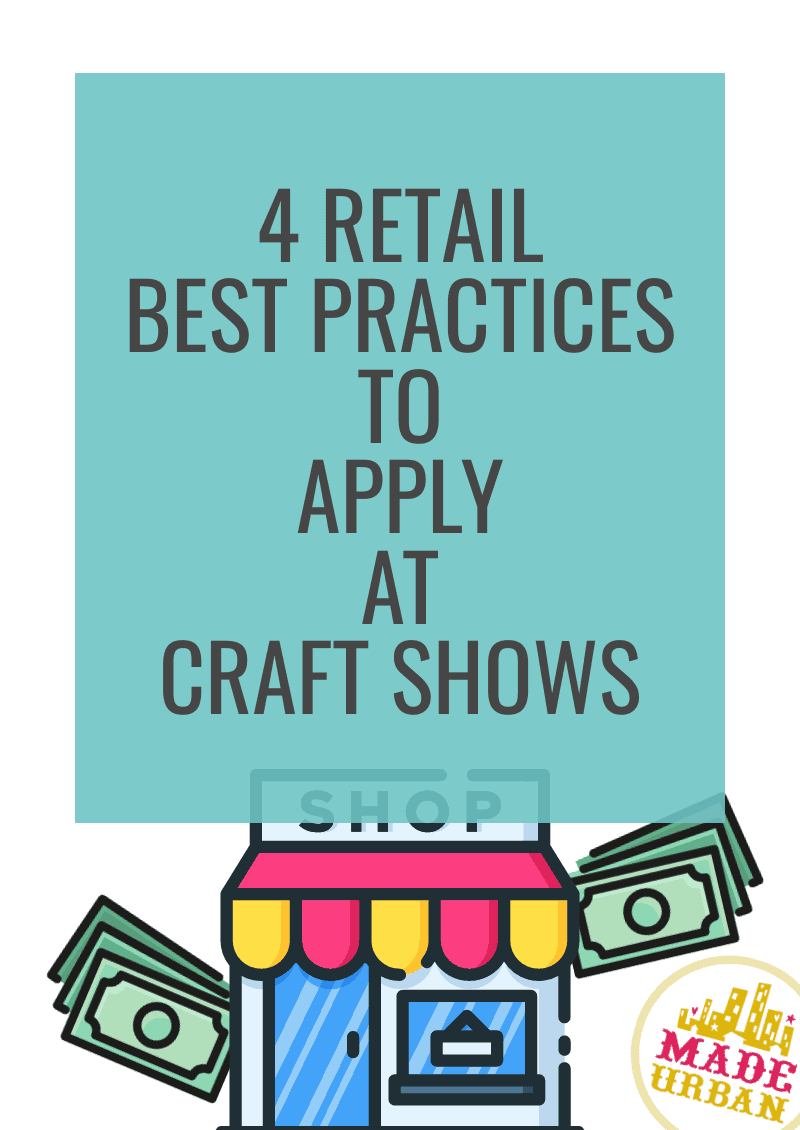4 Retail Best Practices to Apply at Craft Shows
If you walk into any retailer at the mall, you’ll find that almost all of them follow similar techniques for catching a shopper’s eye, drawing them in, and selling to them.
These tried and true strategies can boost your sales at craft shows.
Retail best practice #1: Window Displays
Retailers use the windows of their stores to tell a story at a glance. They know they only have a few seconds to grab attention and intrigue shoppers/passersby to head in. A good window display is interesting and tells a simple story (e.g. “back to school” story) or evokes a feeling (e.g. romantic). It’s often based on a theme to coordinate with a season, trend, occasion, etc.
How to use it at a craft show
If you have a table at a craft show, you may either treat your entire space like a shop window (to grab attention and tell a story/evoke a feeling) or you may have one element of your display for that.
If you have a 10′ x 10′ booth that shoppers walk into, you may want to treat the front of your booth as your “store window” and create an eye-catching, story-telling display at the front corner(s).
Think about the story you want to tell, the feeling you want to evoke, or the theme you want your display to follow. It doesn’t have to be complicated and can be as simple as:
- A “back to school” story that incorporates a plaid tablecloth and a few school-themed props.
- A “feminine” or “romantic” feeling by using light colors, pinks, purples, or red throughout the display.
- A “fall” theme that incorporates deep reds and oranges.
Retail best practice #2: Zone 1
In a retail store, zone 1 is the front table or display area the shopper will see when they enter the store. It houses products the retailer wants to draw attention to; it may even display the pieces featured in the window display.
Retailers may also treat this as a “decompression zone” where they allow shoppers to adjust to their settings without being sold to. Zone 1 should be eye-catching, relevant, and updated frequently to keep it fresh and full since items placed here usually sell fast.
How to use it at a craft show
Which area of your booth will shoppers see first? If you have a bigger booth that shoppers can walk around in, you may want to dedicate your front table to your zone 1. If you have an 8-foot table, your zone 1 will simply be a section of your table. And that section should be the end of the table the majority of shoppers will approach first.
Your zone one should catch shopper attention and draw them in. You may use an eye-catching display element (such as an oversized prop, a bold color, etc.) or display a popular or trending product.
>> Learn more about how to create zones in your craft show setup here: Craft Show Table Layout Tips
Although you don’t have as much space or time to allow shoppers to “decompress” in your space, you can still offer the first minute or two of someone being at your craft show table to allow them to take in your work, without selling to them. Saying “hi” and then keeping the conversation light (here are some simple conversation starter ideas) or allowing them to browse before diving into your sale pitch will likely make them feel more comfortable.
Once they’ve moved into your space a little more (even if that means shuffling to the middle of your table), then you can give them your sales pitch.
Retail best practice #3: Setting sales goals
I worked as a visual merchandiser for several multi-million dollar retailers and sales goals were always the biggest focus. Every morning, before the doors opened, there would be a small “staff meeting” to discuss the month’s sales goal, if the store was on track, what they had to sell that day and techniques they would implement to help reach that goal (e.g. promoting best-selling items, cross-selling, etc.).
How to use it at a craft show
Although “selling” can feel inauthentic to us creatives, it’s something we do need to focus on to build a profitable business. Setting a sales goal can keep you focused and push you to actually “sell” your products (rather than simply show them).
You’ll be surprised at how close you get to a number by simply setting a goal.
Start with how much you’ll need to sell to cover the costs of the craft show (e.g. table fee, parking, food, your wages, etc.)
>> Here are the costs you’ll most likely need to cover: 10 Costs of Selling at Craft Fairs
Then think about how much you’d like to profit after those costs are covered. It helps if you have a reason behind that profit goal. What will you do with the profits? Do you want to invest it back into your business and buy a new sewing machine or buy more materials so you can sell more next month? Or are you saving for something outside of your business?
Once you have your sales goal (how many sales you need to make to cover all your costs for the event and be left with your desired profit), then start breaking it down. How many products must you sell? Which products will help you best reach that goal (e.g. your most profitable or popular products)? On average, how many sales will you need to make per hour at the event?
These details will help you make decisions that will get you to your goal. You’ll have a clear idea of how much stock to make, which items to make more of, which items to feature in your zone 1, etc.
Retail best practice #4: Adding on
Think of the items you see at the check-out of your grocery store; candy bars, gum, magazines, etc. These most likely aren’t the items that drove you to the store, but while you’re standing in line, you might impulsively add them to your cart.
These items are often a lower price point and smaller so they don’t require much contemplation to add to a cart.
- At a shoe store, the add-ons might be shoe protectors, shoe cleaners, or shoe laces.
- Toy stores might have batteries or gift-wrapping items close to their checkout.
- Clothing stores might display jewelry and smaller accessories that people can browse while waiting in line.
How to use it at a craft show
First, consider which products will be your meat and potatoes and which will be your sides. For example, if handbags are the main item I’m selling, coin purses, keychains, purse charms, etc. would be the sides. They’re smaller, lower in price, and complement the main product my customers are likely to buy.
Consider smaller, cheaper items you can make that will complement your main products.
Next, consider where your “checkout” area will be. In a booth, you may have the space to set up a checkout desk. Consider how most shoppers will enter your booth and where they will leave; this is where your checkout desk should go.
If you have an 8-foot table, your checkout area should be at the opposite end of your zone 1.
Place your smaller add-on items in or close to your checkout so that people can browse them while you’re wrapping their purchase and easily add them to their order.
Which best practices are you going to apply at your next craft show?


Hey, I’m Erin 🙂 I write about small business and craft show techniques I’ve learned from being a small business owner for almost 2 decades, selling at dozens of craft shows, and earning a diploma in Visual Communication Design. I hope you find my advice helpful!

Well, besides bringing work in various price points, I figure out my most lucrative work and give those items the best spot in my display. I even display them in a gift box. I subtly push these items and bring lots of back stock so that I have plenty throughout the whole show to the very end. People often rush in at the end for more and are delighted when they get it.
Your articles are my favorite on Pinterest. I read them, learn, re read them, learn again- and repeat! Thankyou for taking the time to thoughtfully write them! I love them ALL!!!
Thank you so much Mary-Jo!! That makes me so happy 🙂 I’m glad you’re finding them helpful and I appreciate you taking the time to leave me feedback.
Happy reading!
~Erin